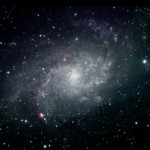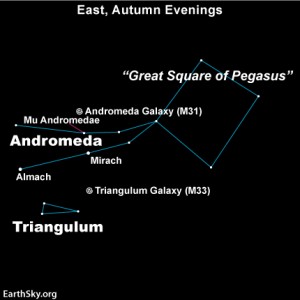
Although long-exposure photographs show the Triangulum galaxy (Messier 33) as a pinwheel of swarming suns, this face-on spiral galaxy looks rather lackluster in binoculars or even the telescope. The Triangulum galaxy has a low surface brightness that makes this faint object a major challenge, with or without optics.
Have you ever seen the Great Andromeda Galaxy (Messier 31)? If not, try finding the Andromeda galaxy before you take on the Triangulum galaxy. Shining 8 to 9 times more brightly than the Triangulum galaxy, the Andromeda galaxy is the most distant object that you can easily see with the unaided eye. Fortunately, the Triangulum and Andromeda galaxies are a relatively close 15 degrees apart. (For reference, a fist-width at an arm length approximates 10 degrees.)
Star-hop to the Andromeda galaxy to orient yourself to the Triangulum galaxy. As seen on the sky chart, the star Mirach stands about midway between the two galaxies. Our Andromeda galaxy sky chart shows you how to star-hop to the Andromeda galaxy. Once you’ve found it, the Andromeda galaxy and Mirach point in the general direction of the Triangulum galaxy.
The constellation Triangulum
Learn the constellation Triangulum, the small triangle made of three rather faint yet visible stars. Look eastward on some autumn evening, placing the star Alpha Triangulum at about the “7 o’clock” position in your binoculars. The Triangulum galaxy appears at the opposite side of the binouclar field, somewhere around 1 or 2 o’clock.
Now for a word of warning: even if you’re staring right at the Triangulum galaxy, it’s still possible to miss it. You won’t see the galaxy’s stars at all. Sometimes, this galaxy looks almost transparent, like a water spot on a window. The small blob in your binocular field might resemble an unwashed spot on an otherwide clean window. If you’ve never seen this deep-sky object before, it’s hard to know what to look for. Once you finally spot the Triangulum galaxy, you may wonder how you overlooked it so easily so many times before.
Science
At a distance of about 2.7 million light-years, the Triangulum galaxy might be a satellite galaxy of the Andromeda galaxy. The diameter of the Triangulum galaxy is about 50,000 light-years, or about one-half that of our Milky Way. After the Milky Way and Andromeda galaxies, the Triangulum galaxy ranks as the third largest of the few dozen galaxies inhabiting our Local Group of Galaxies.
from EarthSky http://earthsky.org/clusters-nebulae-galaxies/triangulum-galaxy-m33-a-binocular-challenge

Although long-exposure photographs show the Triangulum galaxy (Messier 33) as a pinwheel of swarming suns, this face-on spiral galaxy looks rather lackluster in binoculars or even the telescope. The Triangulum galaxy has a low surface brightness that makes this faint object a major challenge, with or without optics.
Have you ever seen the Great Andromeda Galaxy (Messier 31)? If not, try finding the Andromeda galaxy before you take on the Triangulum galaxy. Shining 8 to 9 times more brightly than the Triangulum galaxy, the Andromeda galaxy is the most distant object that you can easily see with the unaided eye. Fortunately, the Triangulum and Andromeda galaxies are a relatively close 15 degrees apart. (For reference, a fist-width at an arm length approximates 10 degrees.)
Star-hop to the Andromeda galaxy to orient yourself to the Triangulum galaxy. As seen on the sky chart, the star Mirach stands about midway between the two galaxies. Our Andromeda galaxy sky chart shows you how to star-hop to the Andromeda galaxy. Once you’ve found it, the Andromeda galaxy and Mirach point in the general direction of the Triangulum galaxy.
The constellation Triangulum
Learn the constellation Triangulum, the small triangle made of three rather faint yet visible stars. Look eastward on some autumn evening, placing the star Alpha Triangulum at about the “7 o’clock” position in your binoculars. The Triangulum galaxy appears at the opposite side of the binouclar field, somewhere around 1 or 2 o’clock.
Now for a word of warning: even if you’re staring right at the Triangulum galaxy, it’s still possible to miss it. You won’t see the galaxy’s stars at all. Sometimes, this galaxy looks almost transparent, like a water spot on a window. The small blob in your binocular field might resemble an unwashed spot on an otherwide clean window. If you’ve never seen this deep-sky object before, it’s hard to know what to look for. Once you finally spot the Triangulum galaxy, you may wonder how you overlooked it so easily so many times before.
Science
At a distance of about 2.7 million light-years, the Triangulum galaxy might be a satellite galaxy of the Andromeda galaxy. The diameter of the Triangulum galaxy is about 50,000 light-years, or about one-half that of our Milky Way. After the Milky Way and Andromeda galaxies, the Triangulum galaxy ranks as the third largest of the few dozen galaxies inhabiting our Local Group of Galaxies.
from EarthSky http://earthsky.org/clusters-nebulae-galaxies/triangulum-galaxy-m33-a-binocular-challenge


Aucun commentaire:
Enregistrer un commentaire